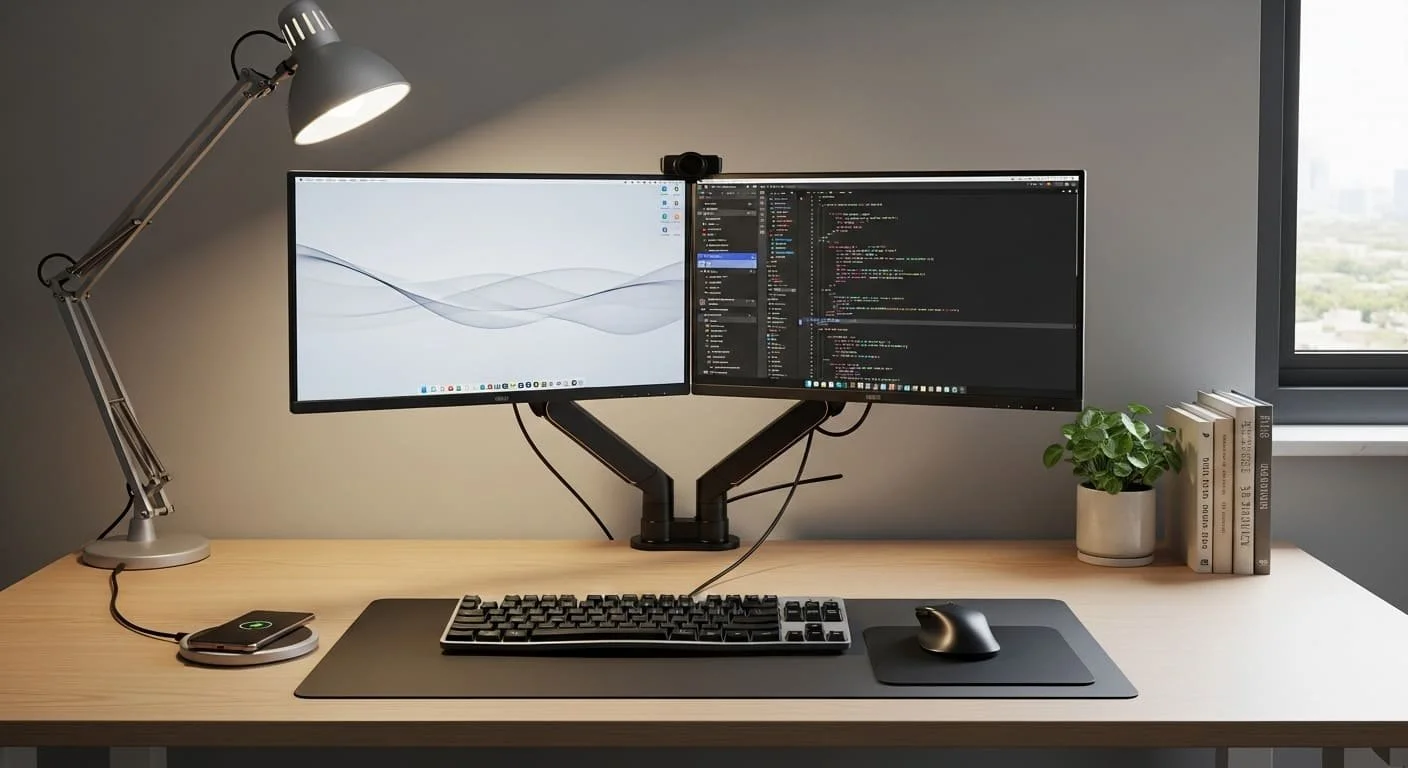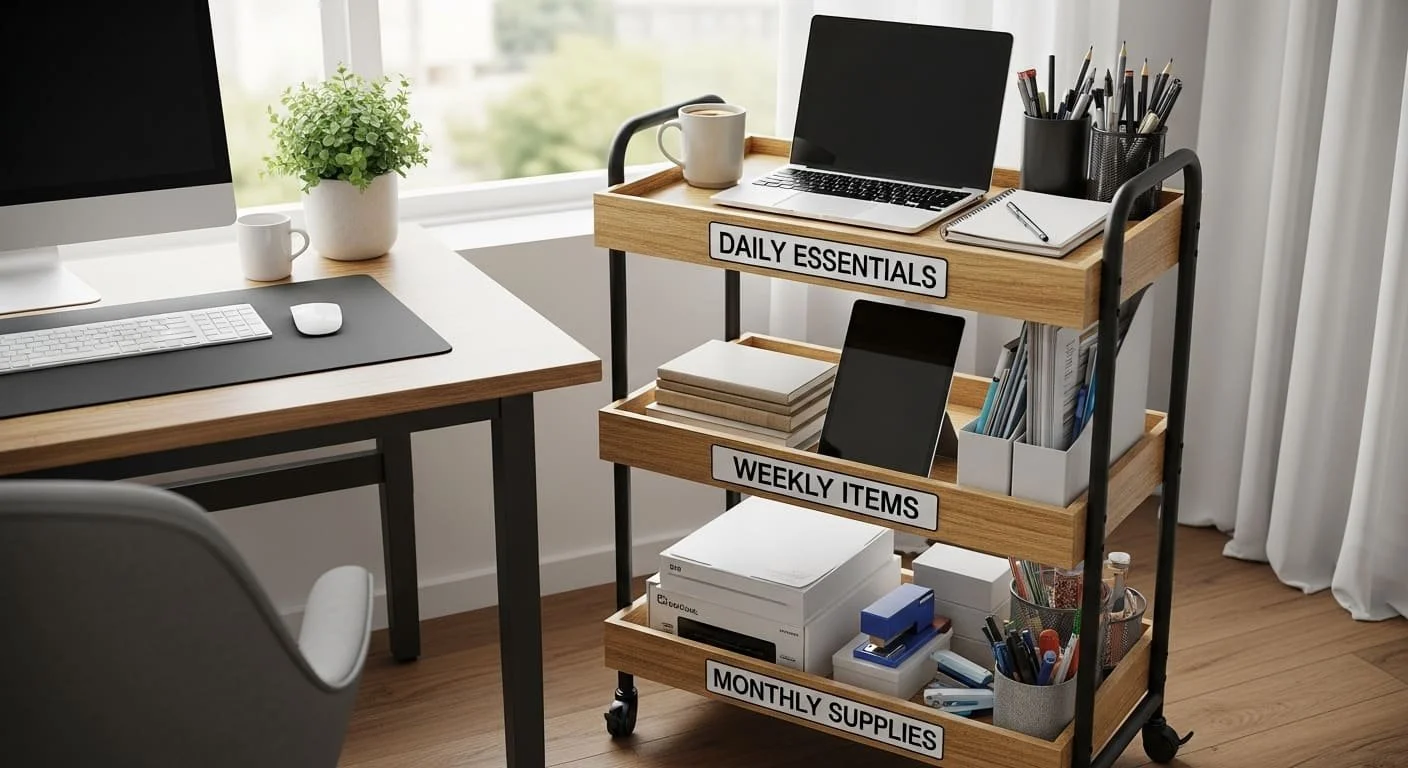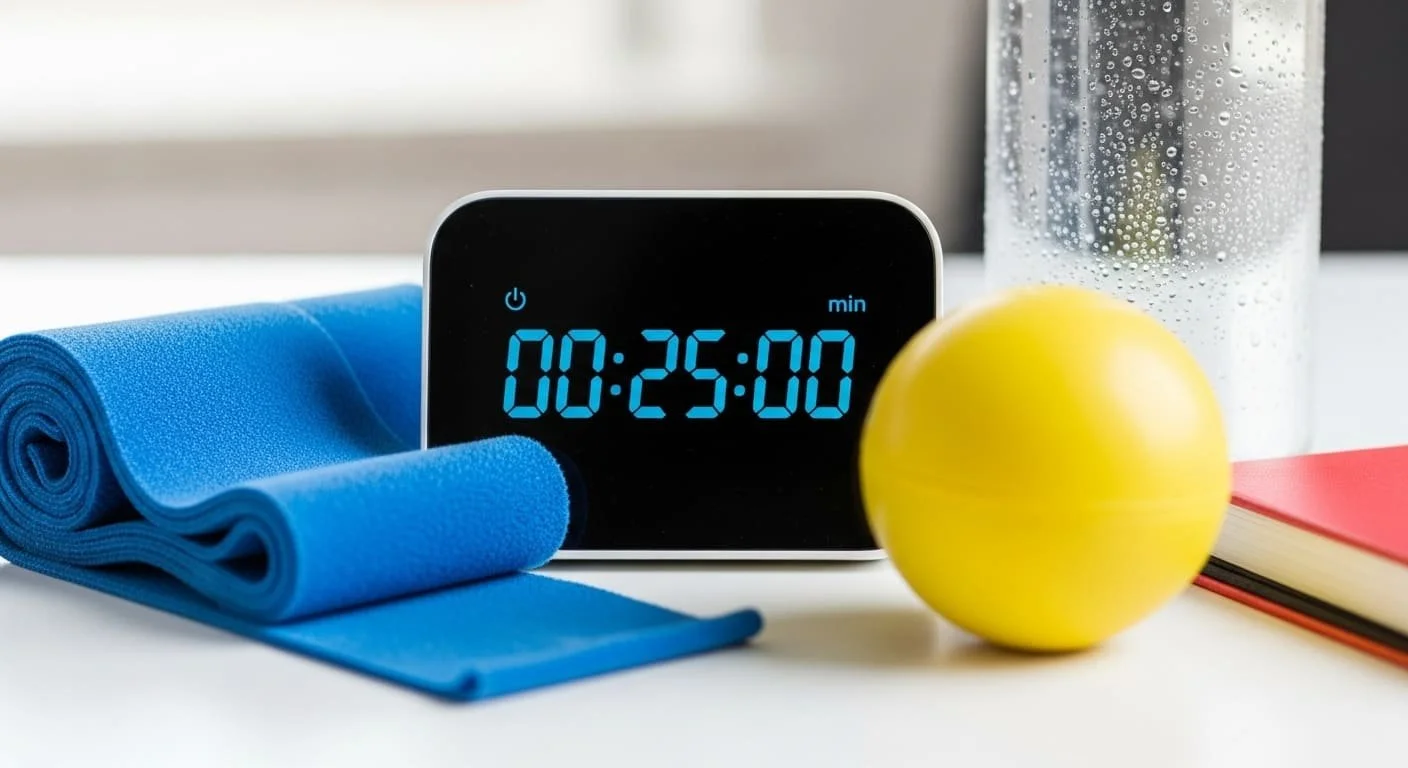Transform Your Workspace: Expert Advice for Remote Work with MS
Article Brief
Remote work promised freedom for people with multiple sclerosis. No more exhausting commutes during flare-ups, no more hiding symptoms in open offices, and no more one-size-fits-all workspaces that ignore your body's needs. But here's what nobody tells you: working from home with MS isn't automatically easier. Without the right setup, you'll find yourself battling fatigue, wrestling with brain fog, and struggling against equipment that works against your symptoms instead of with them.
This comprehensive guide cuts through the generic "work from home" advice to deliver real solutions for real MS challenges. You'll discover which ergonomic investments actually pay off (hint: it's not what most articles recommend), how to organize your space for cognitive fluctuations, and why your current setup might be sabotaging your energy levels without you realizing it. From temperature control strategies that matter to technology tools that adapt to your daily reality, we're covering everything you need to build a remote workspace that doesn't just accommodate MS—it helps you thrive with it.
Whether you're newly remote, newly diagnosed, or just tired of feeling like you're working harder than you need to, this guide will transform how you think about productivity with MS. Ready to stop fighting your workspace and start making it work for you?
Let's be real: working from home with multiple sclerosis isn't just about swapping your commute for coffee in your pajamas. It's about creating a workspace that actually works with your body, not against it. And if you're tired of feeling like you're fighting an uphill battle every single day, buckle up—we're about to change that.
The remote work revolution hit everyone hard, but for people with MS, it was honestly a godsend. No more exhausting commutes during flare-ups, no more pretending you're fine when fatigue hits like a freight train, and no more office chairs that make your back scream by 2 PM. But here's the catch: just because you're working from home doesn't mean you've automatically solved all your MS-related work challenges.
The difference between a good remote work setup and a life-changing one? Knowing exactly what your body needs and refusing to settle for "good enough."
The Foundation: Your Workspace Essentials
The difference between a standard chair (left) and an MS-friendly ergonomic chair (right) isn't just comfort—it's about preventing the cascading fatigue that poor posture creates. Notice how the ergonomic option supports your spine's natural curve, keeps your arms at the right height, and maintains proper alignment that reduces energy drain throughout your workday.
The Desk Situation That'll Save Your Sanity
Forget everything you think you know about desks. That beautiful fixed-height table you've been eyeing on Instagram? Skip it. Your new best friend is a sit-stand desk with memory presets. The UPLIFT V2 and Flexispot E7 are the gold standards here, letting you switch between sitting and standing faster than your energy levels can crash.
But here's the insider secret: get one with at least three memory presets. One for sitting, one for standing, and one for that magical "leaning" height that hits just right when brain fog rolls in and you need to feel productive without fully committing to either position.
Seating: Where Comfort Meets Function
Your chair isn't furniture—it's medical equipment. The Herman Miller Aeron gets all the headlines, but the Steelcase Leap V2 often works better for MS symptoms. Why? Better lumbar support that adjusts to your daily energy fluctuations, and armrests that actually move where you need them.
Can't swing premium prices? The SIHOO M18 offers surprising ergonomic support at a fraction of the cost. Whatever you choose, make sure it has adjustable everything: height, armrests, lumbar support, and seat depth.
Technology That Actually Gets It
This dual monitor setup eliminates the neck strain and eye fatigue that can trigger MS symptoms. The adjustable monitor arms let you change screen height throughout the day as your energy shifts, while the ergonomic keyboard and vertical mouse reduce repetitive strain that compounds fatigue.
Monitor Magic for Foggy Brain Days
Dual monitors aren't a luxury when you have MS—they're a necessity. But not just any monitors. You want 24-27 inch screens with blue light filtering and brightness that adjusts automatically throughout the day. The Dell UltraSharp series offers excellent color accuracy without the eye strain that can trigger headaches.
Pro tip: Mount them on adjustable arms so you can change the height and angle throughout the day. When fatigue hits, being able to lower your screens slightly can make the difference between pushing through and calling it quits.
Keyboard and Mouse: Small Changes, Big Impact
Standard keyboards and mice are basically designed to create repetitive strain injuries. Switch to an ergonomic keyboard like the Microsoft Sculpt or Logitech MX Keys, and pair it with a vertical mouse like the Anker Wireless Vertical Mouse.
Your wrists will thank you, and you'll notice less overall fatigue from unnecessary muscle tension. Trust us on this one.
For more specific accommodation ideas and legal guidance on workplace modifications, the Job Accommodation Network offers detailed MS accommodation suggestions that can help you advocate for the tools you need.
Climate Control: Your Secret Productivity Weapon
MS symptoms love to party when temperatures fluctuate, so consistent climate control isn't optional. A good desk fan (try the Vornado Flippi V6) can create personal air circulation without affecting the whole room. For heat sensitivity, cooling towels and a mini-fridge stocked with cold drinks within arm's reach are game-changers.
Cold sensitivity? Invest in a small space heater with precise temperature control and a heated mouse pad. Yes, heated mouse pads are a thing, and yes, they're amazing.
Lighting: Set the Mood, Save Your Energy
Harsh fluorescent lighting is the enemy of everyone with MS. Instead, layer your lighting: a bright desk lamp for focused work (the BenQ ScreenBar is perfect), ambient lighting to reduce eye strain, and adjustable color temperature bulbs that shift warmer throughout the day.
Philips Hue bulbs let you create custom lighting scenes for different energy levels and times of day. "Morning motivation," "afternoon focus," and "evening wind-down" aren't just cute names—they're actual productivity tools.
Organization Systems That Work When Your Brain Doesn't
The "everything within arm's reach" principle in action. This three-tier system means you never have to choose between getting supplies and conserving energy during flare-ups. Daily essentials stay at eye level, while less frequent items are stored below—simple organization that adapts to your energy levels.
The "Everything in Arm's Reach" Rule
On good days, getting up for supplies feels easy. On tough days, it can derail your entire workflow. Keep frequently used items within arm's reach: pens, notebooks, phone charger, medications, snacks, and water.
A rolling cart next to your desk works perfectly for this. Stock the top shelf with daily essentials, the middle with weekly items, and the bottom with monthly supplies.
Digital Organization for Scattered Days
When brain fog hits, complex filing systems become impossible. Use a simple three-folder system: "Today," "This Week," and "Later." Everything gets sorted into one of these categories, and you review and re-sort weekly when your mind is clearer.
Cloud storage with automatic syncing (Google Drive, Dropbox, or OneDrive) ensures your work is always accessible, even if you need to switch between devices mid-day.
Email management becomes especially crucial when cognitive symptoms make organization challenging—tools like SaneBox can automatically organize your inbox so you don't have to waste mental energy on email sorting during flare-ups.
Managing Energy Throughout Your Workday
The visual reminder that productivity with MS isn't about pushing through—it's about pacing strategically. This 25-minute timer setup with immediate access to restoration tools (stretching band, stress ball, hydration) makes energy management automatic, not an afterthought.
The 25-5 Rule That Actually Works
The Pomodoro Technique suggests 25 minutes of work followed by 5-minute breaks. For MS, flip it: 25 minutes of focused work, then 5-10 minutes of genuine rest. Not scrolling social media—actual rest.
Use this time for gentle stretching, deep breathing, or just closing your eyes. Your afternoon energy crash will become much more manageable.
Scheduling Around Your Body Clock
Track your energy patterns for two weeks and schedule demanding tasks during your naturally high-energy times. Most people with MS have a "golden window" of peak performance—identify yours and protect it fiercely.
Understanding the difference between brain fog and fatigue helps you optimize your schedule—cognitive tasks work better during clear-headed periods, while routine tasks can be saved for when mental fog rolls in.
Technology Tools for Symptom Management
Apps That Actually Help
MS Connect helps track symptoms and energy levels, making it easier to identify patterns and plan your workday accordingly. For voice-to-text on difficult typing days, Dragon NaturallySpeaking remains the gold standard, though built-in options on smartphones are getting surprisingly good.
Calendly or similar scheduling tools eliminate the back-and-forth of meeting planning, conserving mental energy for actual work.
Creating Boundaries That Stick
The "Office Hours" That Matter
Just because you work from home doesn't mean you're available 24/7. Set clear boundaries with family members about when you're working and when you're not. A simple door sign or designated work clothing can signal "in the office" mode.
More importantly, set boundaries with yourself. When the workday ends, it ends. Resist the temptation to "just check one more email" when you should be resting.
If you need help establishing workplace accommodations or understanding your rights as a remote worker with MS, the National Multiple Sclerosis Society's employment resources provide comprehensive guidance on legal protections and accommodation strategies.
Making It Sustainable Long-Term
The Upgrade Timeline
Don't try to build the perfect setup overnight. Start with the essentials: chair, desk height, and basic organization. Add pieces monthly as budget allows and as you identify what would make the biggest difference in your daily experience.
Regular Setup Reviews
MS symptoms change, which means your optimal setup will too. Schedule quarterly reviews of your workspace. What's working? What's causing problems? What new challenges have emerged?
Your future self will thank you for staying ahead of these changes instead of just reacting to them.
The Bottom Line
Creating an MS-friendly remote work setup isn't about spending the most money or having the fanciest equipment. It's about understanding your body's needs and building a workspace that adapts to your daily reality instead of fighting against it.
The best remote work setup for MS is the one that makes you forget you're dealing with MS symptoms at all. It should feel seamless, supportive, and sustainable—not like another thing you have to manage on top of everything else.
Start with one element that would make the biggest immediate difference in your workday. Maybe it's the chair that's been killing your back, or the monitor that's been straining your eyes. Small changes compound into significant improvements, and your productivity (and sanity) will thank you for it.
The Multiple Sclerosis International Federation's work guidance offers additional global perspectives on managing employment challenges with MS.
Remember: you deserve a workspace that works as hard as you do. Stop settling for setups that make your job harder than it needs to be.
FAQS (7 Questions):
Q1: What's the most important piece of equipment for a remote work setup with MS?
A: An ergonomic, adjustable chair with proper lumbar support. You'll spend 6-8 hours in this chair daily, and poor seating can worsen fatigue, pain, and posture issues that compound MS symptoms.
Q2: How much should I budget for an MS-friendly home office setup?
A: Start with $500-$800 for essentials (chair, desk adjustments, basic ergonomics), then add $100-200 monthly for upgrades. A complete premium setup ranges from $2,000-$4,000, but you can build it gradually.
Q3: Should I get a sit-stand desk if I have MS?
A: Yes, but only if it has memory presets for quick position changes. Manual crank desks require too much energy when fatigue hits. Electric desks with programmable heights let you adapt quickly to changing energy levels.
Q4: How do I manage temperature sensitivity in my home office?
A: Layer your climate control: personal desk fan, space heater, cooling towels, and heated accessories (mouse pad, seat cushion). This gives you precise control without affecting the whole house.
Q5: What lighting setup works best for MS symptoms?
A: Avoid overhead fluorescents. Use layered lighting: bright desk lamp for focused work, ambient lighting to reduce eye strain, and adjustable color temperature bulbs that warm up throughout the day to support natural circadian rhythms.
Q6: How often should I take breaks during remote work with MS?
A: Every 25-30 minutes, take a 5-10 minute break. Unlike standard productivity advice, these should be genuine rest periods—stretching, breathing exercises, or simply closing your eyes—not checking social media.
Q7: Can I use voice-to-text software for work tasks?
A: Absolutely. Dragon NaturallySpeaking is the most accurate, but built-in smartphone and computer voice recognition has improved significantly. This is especially helpful during flares when typing becomes difficult.




